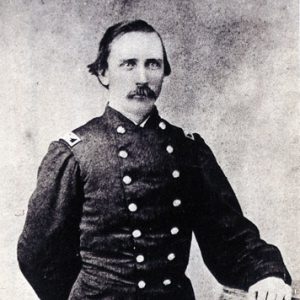calsfoundation@cals.org
John E. Phelps (1839–1921)
John E. Phelps recruited and served as colonel of the Second Arkansas Cavalry Regiment (US), which saw extensive service in northern Arkansas and in Missouri during the Civil War.
John Elisha Phelps was born in Springfield, Missouri, on April 6, 1839, one of five children of John Smith Phelps and Mary Whitney Phelps. He attended school in Fayetteville (Washington County) but finished his education at a private school in Springfield. He went into business for himself at age thirteen, buying and selling cattle, and in 1859, he and two others established a wholesale grocery store in Springfield, with Phelps also traveling on horseback to sell items.
When the Civil War began, Phelps acted as a volunteer scout for the Union troops involved in the August 10, 1861, Battle of Wilson’s Creek in Missouri, after which he performed similar duties for Major General Samuel R. Curtis. He became an aide to Colonel Eugene A. Carr and was serving in that capacity when he was wounded in the March 6–7, 1862, Battle of Pea Ridge, after which he was commissioned as a second lieutenant in the Third U.S. Cavalry, his first official military position. He was later promoted to first lieutenant in the Third.
Phelps stayed on Carr’s staff throughout the Pea Ridge Campaign, riding into Helena (Phillips County) with Curtis’s Army of the Southwest in July 1862. His father was named military governor of Arkansas and, in that role, appointed his son as recruiting officer to raise the Second Arkansas Cavalry Regiment (US). Phelps crossed the Mississippi River and fought in many of the actions around Vicksburg, Mississippi, before being sent home because of the effects of malaria.
He finished recruiting the Second Arkansas Cavalry and was mustered in as colonel of the regiment on March 18, 1864, on an appointment by President Abraham Lincoln. He commanded the regiment throughout the war as it fought in Missouri, northern Arkansas, and Tennessee, though apparently the only time he led it in combat conditions in Arkansas was in the January–February 1864 expedition against guerrilla leaders such as Thomas R. Freeman that included the Skirmish at Crooked Creek.
He married Margaret J. White of Springfield on July 21, 1864; they had three children.
Phelps and the Second Arkansas saw hard service during Major General Sterling Price’s failed Missouri raid in late 1864, and Phelps received a brevet promotion to brigadier general of volunteers for “gallant and meritorious service in the fall campaign of 1864 in Southwest Missouri.” He also received brevet promotions to captain, major, and lieutenant colonel in the regular army. Suffering long-term effects of malaria, Phelps mustered out of military service in September 1865.
After the war, President Andrew Johnson appointed him as receiver of public moneys in Springfield in 1866, a position he held for three years. He later worked as a traveling salesman, miner, and farmer. He was active in the Grand Army of the Republic (GAR), an organization of Union Civil War veterans, and was elected head of the GAR’s Missouri Division in 1889. He later lived in Tacoma, Washington, and in Pasadena, California, where he died of pneumonia on September 16, 1921. He is buried in Springfield’s Hazelwood Cemetery.
For additional information:
“Col. J.E. Phelps.” Springfield News-Leader, September 18, 1921, p. 10.
“General Phelps Dies in California.” Arkansas Gazette, October 23, 1921, p. 11.
“Missouri.” National Tribune, April 11, 1889, p. 8.
History of Greene County, Missouri. St. Louis: Western Historical Company, 1883.
Hunt, Roger D., and Jack R. Brown. Brevet Brigadier Generals in Blue. Gaithersburg, MD: Olde Soldiers Books, 1990.
Ross, Margaret. “General Holland Comes to Command New Force.” Arkansas Gazette, February 1, 1964, p. 4B.
———. “General Sanborn Sends Three Units to North,” Arkansas Gazette, January 20, 1964, p. 8A.
The War of the Rebellion: A Compilation of the Official Records of the Union and Confederate Armies, Series I, Vol. 34, part 1. Washington DC: Government Printing Office, 1891.
Mark K. Christ
Central Arkansas Library System


 John E. Phelps
John E. Phelps 



Comments
No comments on this entry yet.